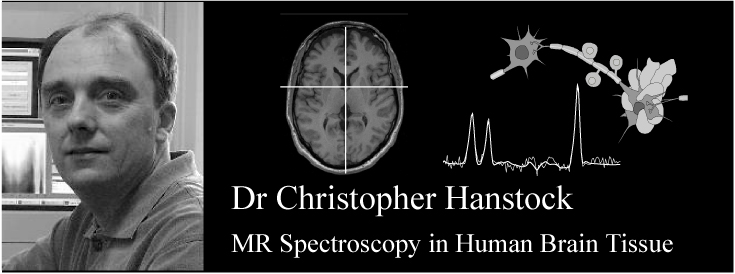Dr Chris Hanstock
Contact information:
Department of Biomedical Engineering,
1098 RTF Building, 8308-114 Street, University of Alberta
Edmonton, Alberta, Canada T6G 2V2
780-492-2542 (office)
780-492-8259 (FAX)
Email: hanstock@ualberta.ca
Biography:
Dr Hanstock is a faculty service officer in the Department of Biomedical Engineering.
Graduate Royal Society of Chemistry (1976)
Ph.D. (1981), Staffordshire University, UK.
Chartered Chemist, Member of the Royal Society of Chemistry, UK 1981.
Joined University of Alberta in 1981.
Current Research:
My research program, since joining the NMR Facility at the University of Alberta in 1985 and during 1 year periods at Yale University, USA (1987-88) and James Cook University, Australia (1991-92), has focussed on the development and application of NMR techniques that can be used to study in vivo tissue metabolism. In particular, much my work has been in the identification and quantification of brain and muscle metabolites, as observed by 1H, 31P and 13C NMR spectroscopy, and monitoring the changes that result during normal function, or following injury / disease, as well as the effects of a variety of drugs.
Current work, aimed primarily at our brain metabolism program, includes the development of several new techniques (eg. single voxel segmentation, and single voxel J-resolved 2D spectroscopy). Continuing studies are allowing us to monitor the neuro-degenerative diseases ALS (amyotrophic lateral sclerosis) , Huntington's , and Parkinson's. We are also continuing our studies observing the effects and role of lithium and amphetamine on brain metabolism in order to gain a better understanding of the intracellular secondary messenger system, and its role in bipolar disorder. In addition, we are observing the changes in the brain metabolites that occur in schizophrenia for both adults and high-risk adolescents.
Recent projects relating to muscle metabolism include the evaluation of the constrained environment of phosphocreatine at rest and during ischemic fatigue, studies of the effects of maturation on muscle function, and exploring the effectiveness of hyperbaric oxygen to aid muscle repair following injury.
Student Opportunities:
There are no student opportunities.
Publications:
Link to publication list in PubMed
